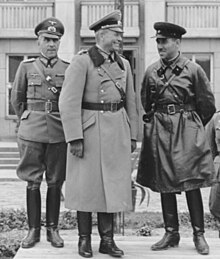Semyon Moisseyevich Krivoschein
Semjon Moissejewitsch Kriwoschein ( Russian Семён Моисеевич Кривошеин ; born November 28, 1899 in Voronezh , † September 16, 1978 in Moscow ) was a Soviet general who played an essential role in the reconstruction of the armored forces of the Red Army and the Soviet victory in the Battle of Kursk played.
Life
Kriwoschein came from a Jewish merchant family and attended grammar school until 1917 . In 1918 he joined the Red Army. He served in Budjonny's 1st Red Cavalry Army , which probably saved his life during the purges of 1937–1938 despite his bourgeois background.
Early military career
After the civil war he studied at the military academy "MW Frunze" , which he graduated in 1931. He then served in the mechanized troops, where he became regimental commander in 1934. In 1936 he volunteered to fight in Spain . In November and December 1936 he commanded the armored forces of the government-loyal troops in the Battle of Madrid .
In January 1937, Krivoschein was recalled to the Soviet Union and promoted to brigade commander. In the summer of 1938 he led his brigade in the Battle of Lake Chassan and took part in the attack on Poland on September 17, 1939 and in the joint German-Soviet victory parade on September 22, 1939 with the general of the tank troop Heinz Guderian . During the parade on the demarcation line in Brest-Litovsk , Krivoschein, on behalf of the Soviet leadership, congratulated the Germans on their war successes and agreed to greet the Germans in Moscow after their impending victory over Great Britain.
Kriwoschein led his brigade in the Winter War against Finland (1939-1940), where he was promoted for his services. In less than two years he rose from regimental commander to commander of armored forces in the Baltic Special Military District and was promoted to major general when the ranks of general in the Red Army were introduced in 1940 .
In the Patriotic War
From March 1941, Kriwoschein commanded the 25th Mechanized Corps in the Kharkov Military District . After Operation Barbarossa began , his troops were transferred to the central section of the Eastern Front and were in combat with German troops who had invaded Belarus . His corps fought on the Western , Central and Brjansk Fronts as part of the 21st and later the 13th Army . The corps proved its worth in the defense of Mogilev and Propoisk in July 1941 . Krivoschein's corps showed itself to be equal to the German tank units and was commissioned by the high command to fundamentally reform the tank troops. From 1941 to 1943 he was head of training in the main directorate of the armored forces of the Red Army. When the Red Army was preparing for the Battle of Kursk , Krivoschein was given command of the 3rd Mechanized Corps in Mikhail Yefimovich Katukov's 1st Panzer Army of the Voronezh Front under Nikolai Fyodorovich Watutin , who succeeded in fierce fighting in repelling the German advance Mechanized Corps was raised to the 8th Guards Mechanized Corps and Krivoschein was promoted to Lieutenant General and awarded the Suvorov Order . In the aftermath of the Battle of Kursk, the 1st Panzer Army took part in the expulsion of German troops from Ukraine.
After Krivoschein had received command of the 1st Mechanized Krasnograd Corps and had led it in Operation Bagration , he advanced with his troops to Brest . At the end of the war in 1945, Krivoschein's corps led the 1st Belarusian Front under Zhukov in the Battle of Berlin . He managed to break through the German positions on the Seelow Heights and to advance to the Reichstag building in Berlin, for which he was honored as a Hero of the Soviet Union .
post war period
Kriwoschein commanded his corps until 1946 and then taught at the military academy "MW Frunze" until 1950. When, in the course of the anti-Semitic campaign in 1950, a majority of the few generals of Jewish descent were dismissed from influential positions in the Soviet Army , Krivoschein was given command of the armored forces in the Odessa military district . The following year, however, he was transferred to the Military Academy of the General Staff of the Armed Forces of the USSR "KJ Voroshilov" , which he graduated in 1952.
The death of Stalin in March 1953 marked the end of Krivoschein's career when the new army command decided to reduce the armed forces. After 35 years of service, Kriwoschein was retired on May 4, 1953 with the rank of Lieutenant General . His awards included three orders of Lenin , three orders of the Red Banner , the Order of Kutuzov 1st class, the Order of Suvorov 2nd class and the Order of the Red Star . Kriwoschein spent the last 25 years of his life writing memoirs.
literature
- Fyodor Davydowitsch Sverdlov: Jewrei-generaly Wooruschennych Sil SSSR. Moscow, 1993, pp. 118-119.
- Richard N. Armstrong: Red Army Tank Commanders. The Armored Guards. Atglen, PA, 1994.
- Rossiiskaia evreiskaia entsiklopedia , Vol. 2. Moscow, 1995, p. 92.
- David M. Glantz, Jonathan M. House: The Battle of Kursk. Lawrence, KS, 1999.
- Mark Shteinberg: Evrei v voinakh tysiachiletii. Moscow, Jerusalem, 2005, p. 38.
Web links
Footnotes
- ↑ Archived copy ( memento of the original dated November 22, 2009 in the Internet Archive ) Info: The archive link was inserted automatically and has not yet been checked. Please check the original and archive link according to the instructions and then remove this notice.
| personal data | |
|---|---|
| SURNAME | Krivoschein, Semjon Moissejewitsch |
| ALTERNATIVE NAMES | Кривошеин, Семён Моисеевич (Russian) |
| BRIEF DESCRIPTION | soviet general |
| DATE OF BIRTH | November 28, 1899 |
| PLACE OF BIRTH | Voronezh |
| DATE OF DEATH | September 16, 1978 |
| Place of death | Moscow |
